
Is your school using social media stories to engage with prospective students? A fun and unique format that combines text, photo, and video elements, stories have become a hot topic in the digital marketing sphere.
Since Snapchat—the original creator of the ‘story’ format—launched in 2011 and proved to be a success, other major social media platforms have jumped at the chance to create similar models. Today, Facebook, Instagram, Messenger, and WhatsApp have their own version of the feature.
While it has been slow to gain popularity on some of these platforms, it has proven to be an extremely powerful tool on others. As a result, schools have more options than ever when choosing which stories platform is best for their digital marketing needs.
Stories present a valuable opportunity for schools to reach out and connect with students using creative and digestible content. Not only does the feature allow you to showcase your school and what it has to offer, it also allows students to engage with you directly.
Read on to learn more about stories and discover ideas for how you can use them to freshen up your current social media marketing initiatives.
What are Stories and How are They Useful for Social Media in Higher Education?
If you’re unfamiliar with social media stories, they are quite simple. You can use your social media accounts to share bite-sized pieces of photo or video content in a format similar to a highlight reel. After being watched, the content disappears, and on most social platforms content is only available for 24 hours. When creating a story, you can either film or take a photo in the app or upload one taken at an earlier time.
Stories are a unique way to engage with prospective students, and because they provide a raw, authentic, and interesting insight into your school, they’re an extremely valuable medium for higher education social media marketing.
Before diving into creative ideas you can use to create stories for your school, let’s take a quick look at the stories options available and their distinguishing qualities.
- Snapchat launched in 2011 and is the original stories platform. It now has 166 million daily active users. Some of Snapchat’s main features include filters, which are fun, interactive overlays, as well as Geotags, which are triggered when you are in a certain location.
- Instagram Stories was launched on the Instagram app in August 2016. Far outpacing Snapchat, Instagram now has 200 million daily active users. When creating a Story on Instagram, you can use filters, Geotags, text, and stickers. Recently, Instagram integrated the use of hashtags into Stories and began allowing verified accounts to link out to external websites.
- Messenger Day was launched recently in March 2017 and is integrated right into Facebook’s Messenger app. When creating a story, you can add a sticker, text, or a filter. Because the platform was launched recently, it’s difficult to tell if Messenger Day will catch on. So far, it seems to be having a slow start.
- Facebook Stories are available in Facebook’s mobile app. Also launched in March 2017, Facebook Stories allows you to add filters, geolocation tags, and text to your stories. Again, because Facebook Stories is relatively new, only time will tell if it enjoys the success of Snapchat and Instagram.
- WhatsApp Status launched in February 2017 hoping to cash in on the stories trend. You can use a text and drawing feature, as well as emojis to decorate your Status. Status has quickly garnered popularity with the app’s 1.2 billion users and now has 175 million daily active users.
Of all the platforms which offer the feature, the two most important for schools are probably Snapchat and Instagram. While both have their unique benefits, Instagram is clearly pulling ahead in terms of growth, popularity, and features. Instagram Stories’ quick success is demonstrated in the graph below:
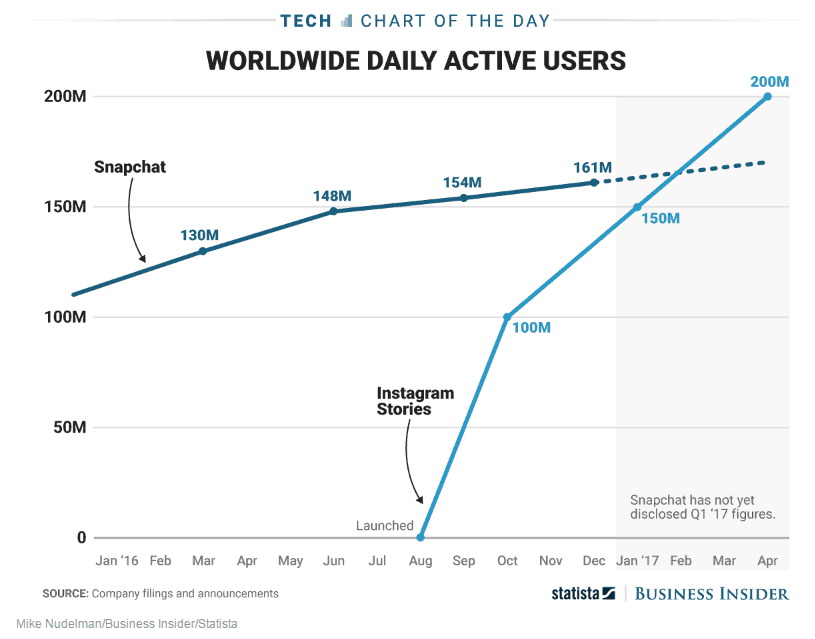
One of the main benefits of Instagram Stories over Snapchat is Instagram Stories’ distribution is “one to many.” This means that prospective students don’t necessarily need to be following your Instagram account to be able to view your Story, and the site will recommend Stories which may be of interest to a user based on their profile. On Snapchat, potential recruits can only view your Story if they have connected with you first, limiting your potential reach.
If your school doesn’t have a Snapchat presence already, using Instagram Stories may make more sense if you already have a substantial following on Instagram. However, many schools find Snapchat a valuable resource, especially for targeting high school aged students and young adults.
Now that you know what platforms are available, let’s take a look at some of the ways schools are using Stories to present their social media content creatively.
1. Student Takeover Stories Give Prospective Students a Peek into Campus Life
When it comes to using stories as a means of recruiting students, authenticity is everything. When students are researching your school and browsing your digital channels, they want a clear picture of what life is like on campus before enrolling. In addition to your school’s website, blog, and social media feeds, stories are a great way to show potential recruits what their experience could be like at your school through the eyes of current students.
A student takeover could involve a single student or group of students uploading photos and videos from around campus, speaking with other students, answering questions, or participating in fun activities, then uploading the results to the platform of your choice.
Example: Colorado State University runs a Takeover Tuesday series using Snapchat Stories. In this example, a current student at the university documents their day on campus while offering to answer prospective and current students’ questions about life at CSU. In the third image, the student host is answering a question submitted by a student through the app.
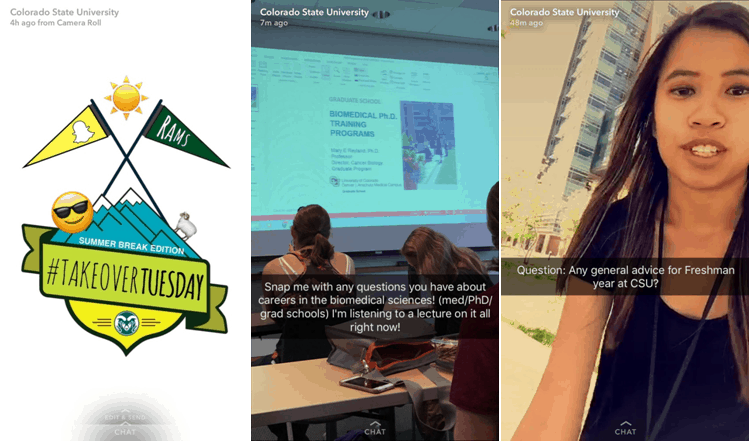
CSU’s series reinforces the core benefit of student takeovers, which is that prospective students are learning what their school experience could be like from the most relevant source—current students. If they don’t personally know anyone attending your school, being able to ask current students questions about life on campus is a valuable resource, and can help them to progress in the decision-making process.
2. Stories Allow You to Showcase Local Attractions to Potential Students on Social Media More Effectively
If you’re looking to attract students who aren’t based locally, you can use your story to showcase your school’s location. Attractions, parks, and monuments all make great features in a story, and emphasizing them provides prospective students a look at what living near your campus is like even if they can’t physically visit before attending.
Example: The University of Westminster boasts its famous location and the iconic Big Ben on its Instagram Story. Using the hashtag feature, the school tags its story with #LONDONISOURCAMPUS. When clicked on, prospective students are taken to a page where they can view all posts that used the same hash tag, which allows them to explore posts and stories about the school even further. This is a great example of a fun, creative way to use social media in education marketing.
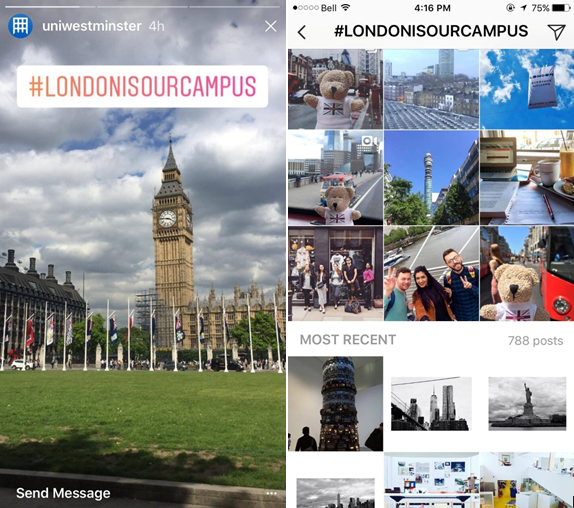
Your school’s location doesn’t necessarily have to be a large, notable town or city to be worthy of promoting. If you are based in a smaller town or less populous city, focus on showing what makes your school’s location unique. Does it have a small town feel? Is there beautiful nature to be explored? For the right prospective student, knowing about these aspects of your location could entice them to study with you.
Example: Central Michigan University is located in Mount Pleasant, Michigan. As of the 2010 census, the city’s population is a modest 26,000 people. Despite its smaller size, it has captivating culture and history, and beautiful nature. CMU promotes its campus location’s benefits with a Snapchat Story series highlighting local attractions and points of interest.

3. Featuring Staff & Faculty in Higher Education Social Media Stories Can Have Huge Benefits
Your staff and faculty are a great resource for your school’s stories. By featuring them, prospective students can easily access their expertise and knowledge by contacting them with questions or comments through the social media platform.
In addition, featuring staff and faculty in your Stories can help potential applicants become familiar with your personnel and the help and resources that will be available to them once they begin attending your school.
Example: The East Carolina University admissions department created a Snapchat Story to answer questions about the admissions process and show what orientation day is like on campus. Seeing events like this in action helps prospective students imagine and get excited about their own orientation day at your school.
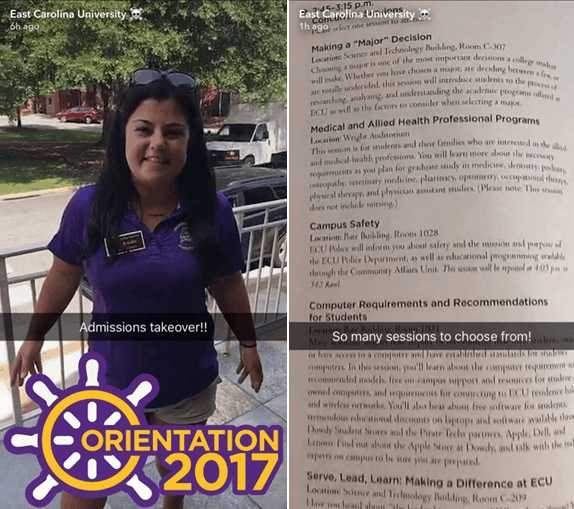
In addition to featuring your school’s regular staff and faculty, consider having your student staff take over your story like the university in this next example. Student staff members will bring a unique and fresh attitude to your story, and they have the authority and ability to answer important questions from potential applicants.
Example: Harvard’s Admissions and Financial Aid Summer Student Coordinators answered prospective and current students’ questions on the Harvard Admissions & Financial Snapchat Story. Students submitted queries about the admissions process, entry requirements, and financial aid options. In this example, a student coordinator is letting viewers know about Harvard’s financial aid opportunities.

Whether it’s about admissions, course content, or internships, your staff and faculty can provide insight into prospective students’ most burning questions. By answering these questions in your story, specifically, which is viewable by everyone, other individuals with the same questions can benefit from the answers.
4. Promote Exciting Events on Social Media by Spotlighting Them in Your Stories
For certain prospective students, campus events and activities are a major deciding factor. While academics are important, potential students will want to make sure that they are going to have a well-rounded, interesting, and fun experience while attending your school. By showcasing exciting events, you demonstrate to potential recruits what you have to offer.
Example: Northeastern University in Boston promotes a high-profile event with the school’s President and city’s Mayor. The university uses the Geotag feature to showcase where the event is taking place, the Carter Playground.
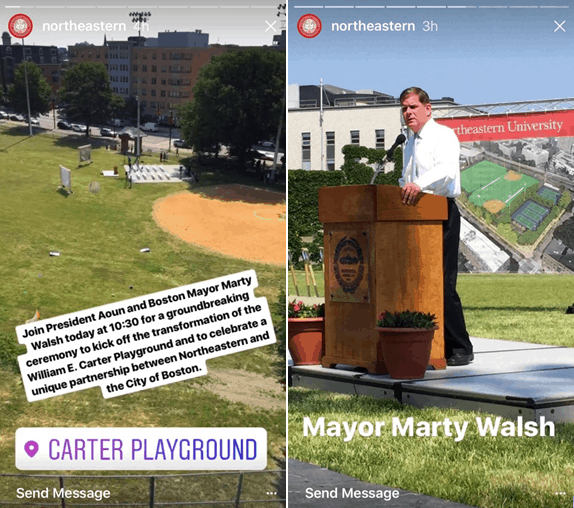
What’s really important to keep in mind while creating stories, which Northeastern does well, is keeping them authentic and natural. Prospective students want to see what your campus is actually like, so avoid using overly edited or stylized photos, which essentially defeat the appeal and purpose of stories. Overtly promotional and staged stories run the risk of coming across insincere, and might make a student question what your campus is actually like on an average day.
The role of social media in higher education marketing is invaluable, and stories only increase the potential impact it can have on your student recruitment initiatives. Stories allow you to meet prospective students where they are, on the social media channels they use, in a content format they are familiar using. They create a personal and inclusive feeling, allowing students to really feel like a part of your campus and helping you to reach out and engage with them in more unique and arresting ways.
As a result, their rise presents a unique opportunity for schools—to bolster your brand identity, and help prospective students understand who you are and what makes your school special.






